Week Two started out with a "Rainbow Windows Math Vitamin" combining area, fractions, and some basic color theory. Educators were greeted with the prompt:
"Welcome artisans! We need your help to construct a Rainbow Stained Glass Window."
Teachers got busy following the instructions:
"Using pattern blocks, build a window on the paper provided.
Make sure you use every color of the rainbow!
That means all the primary colors ( red yellow blue) and all the secondary colors (orange green purple). Because you only have glass in the three primary colors, you are going to need to stack two blocks and visualize in order to create the secondary colors."
The teachers then transferred their blocks onto plastic using kite paper cut-outs.
Then came the Math...
"If the blue rhombus = 1,
What is the total area of your window?
What fraction of your window is a Primary Color?
What fraction is a Secondary Color?
Can you find the fraction of each of the rainbow colors?
Educators varied in their approach, displaying creativity in their mathematical reasoning. Some drew diagrams, while others calculated area by placing the unit of measurement directly on their creation.
The result was a beautiful "stained glass window" through which the light could shine and show how two primary colors combine to create a secondary color!
Next, we introduced ourselves and brainstormed a group list of the Benefits and Challenges of Authentic Arts Integration. This is what we came up with:
Benefits
Students think visually--helps with memory
Helps remove boundaries around subjects--interdisciplinary
Benefits artistically inclined kids
Blends logical and creative sides of the brain
Helps teacher to get to know the student
Develops teacher's interest in something beyond the subject
Creates collaborations with other teachers/students
"Studio Habits of Mind"--Ellen Winner: teaches work ethic/resilience
Practical way of working though problems--teaches planning and going into depth
Teaches problem solving for students and teachers.
Allows for spontaneity
Hands on experience
Teaches self-expression
Kid buy-in helps with participation--esp. reluctant kids
Challenges
How to make it challenging and engaging for older students
How to find the time and resources to implement in the sense of urgency to meet the objectives
How to teach to the exam, when the kids will not get the exam in this format
Teacher buy-in: caliber and belief
Kids who don't enjoy art
Institutional culture doesn't support arts integration
Requires more planning time for teachers/kids (prelim sketches, etc)
Prescriptive teachers: strong beliefs get in the way of teaching art--
example of rigid way of teaching figure drawing
Teachers might engage in false pyscho-analysis
Leaves out "art for art's sake"
Small groups worked together to chose a challenge or two and brainstorm possible solutions.
The two groups then took a "Gallery Walk," switching sides to read each other's lists and using post-it notes to add questions, comments or suggestions.
We will revisit this activity next session as people were absolutely bursting with great thoughts!
Finally we did a resource share, which was very rich with valuable ideas. Here are some of the ones we talked about:
Articles:
Math Vitamins: Developed by AIS' partner University Child Development School.
Fibona-cha-cha Dance and Art using this pattern and the Golden Ratio
Websites:
Fibonacci Sequence In depth description of the golden ratio and it's applications in nature.
Math in a Basket Project using mathematics in a basket weaving activity.
Great Maths Teaching Ideas The 10 Best Maths Teaching Websites
General Art + Math Ideas Document describing some sample lesson plans.
Surface Area + Volume Relationship From Live Mint, using different animals and their jumping heights as examples
Arvind Gupta A wide array of books and projects with ideas for arts out of recycled materials.
Songs for Teaching Uses music to teach early mathematics skills, shapes, money, and telling time.
SPARK Site-- University Child Development School's resource for creating Math Vitamins
Agastya Runs hands-on Science Education Programs in rural India, using "Mobile Labs"
Jodo-Gyan Dehli-based Non-Profit "working to find workable solutions to the problems in classroom practices."
Navnirmit Works to develop and distribute high quality learning materials at low/no cost to promote elementary mathematics and science skills. i
Books:
All about Nothing--The Story of Zero by Nina Sabnani
Mathema-twist--Number tales from around the world by T.V. Padma
MathART Projects and Activities, by Carolyn Ford Brunetto Grades 2-5
Multicultural Math by Claudia Zaslavsky Grades 3-6
Videos:
Khan Academy A series of over 3,000 videos helping you "learn almost anything for free."
Vi Hart: Doodling in Math Class Fun short videos showing doodles ability to address complex math topics.
Jack Black's Math Song Funny song teaches "advanced" math in a funny way.
Teach Me How to Factor Rap song breaks down factoring in a fun way.
Getting Triggy With It Rap about trigonometry teaches about angles using music.
Do the Quad Solve More delightful rapping explains factoring, completing the square, and the quadratic equation.
Multiplication Rap Goes through the x2 and x3 tables in a simple rap.
Ideas:
Using bangles to demonstrate Fractions and Patterns
"Rainbow Window" Math Vitamin


























